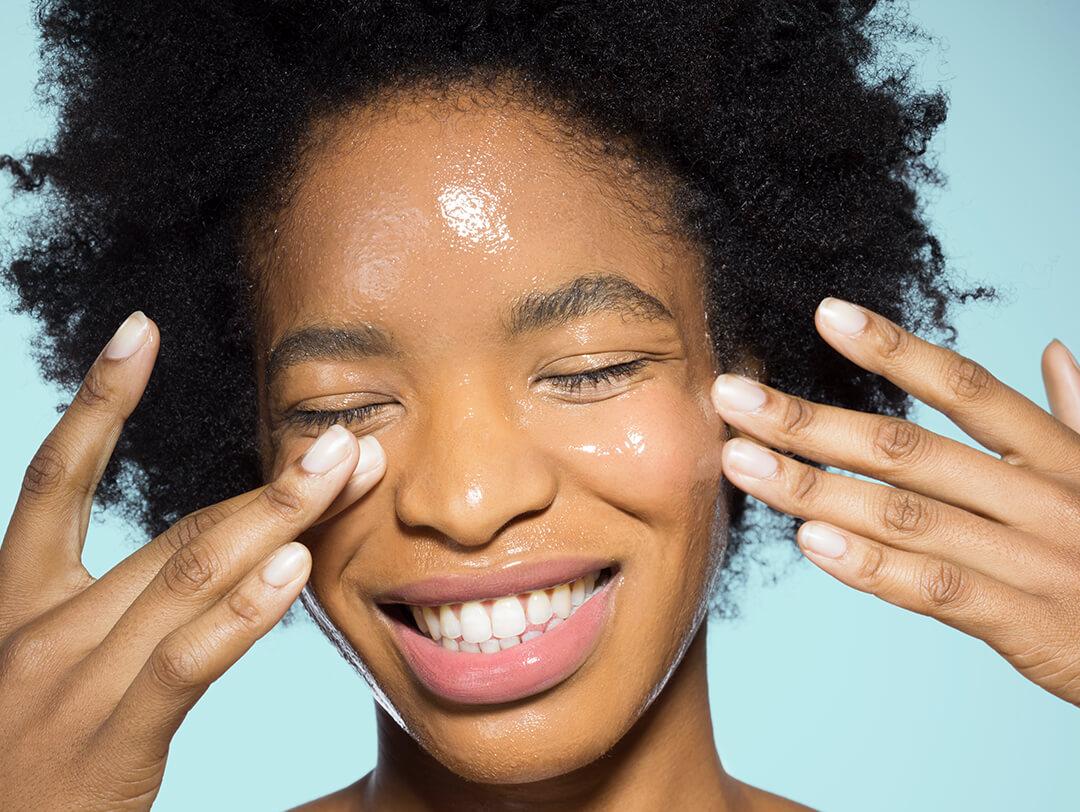TikTok Is Obsessed With the Slugging Skincare Trend—But Is it Derm-Approved?



Lindy Segal


If you’ve been on TikTok, Reddit, or basically any social media recently, you may have heard about skincare slugging. The name may not be super-appealing, but trust us, the skincare technique is not nearly as scary as it sounds—and it’s a game-changer for dry skin. “Highlighted by K-beauty and made popular on Reddit, this process is intended to keep moisture in the skin by preventing transdermal water loss,” explains board certified dermatologist Tracy Evans, MD.
We chatted with Dr. Evans, as well as dermatologist Orit Markowitz, MD, and double board-certified facial plastic surgeon Jaimie DeRosa, MD, to find out everything you need to know about slugging, and exactly how to incorporate the step into your skincare routine. Keep reading to find out if slugging is the right new skincare trick for you.
Want to see more beauty trends? Watch makeup artist Melissa Hurkman test out 4 viral beauty hacks:


It's about glam time you treated yourself.
MEET THE EXPERT
Orit Markowitz, MD, is an Associate Professor of Dermatology at the Icahn School of Medicine at Mount Sinai in New York City.
Jaimie DeRosa, MD, is a double board-certified facial plastic surgeon. She is also the founder and lead facial plastic surgeon of DeRosa Center Plastic Surgery, located in Boston and Palm Beach.
Tracy Evans, MD, is a board certified dermatologist, Mohs surgeon, and medical director of Pacific Skin and Cosmetic Dermatology in San Francisco.
What Is Slugging?
Popular in Korean skincare, “Skincare slugging is the process of covering the skin with an occlusive product such as Vaseline, Aquaphor, or a very heavy cream moisturizer and keeping it on overnight,” explains Dr. Evans. And the name is actually pretty self-explanatory. “The name ‘slugging’ was adopted because it looks similar to having slug slime covering your face,” explains Dr. DeRosa. “Although it’s a new ‘hot’ skincare trend, the theory behind slugging has been around for a long time,” says the surgeon. “As a facial plastic surgeon who routinely performs laser skin resurfacing, I have my patients apply active healing products, such as Alastin™ Skincare Nectar, to their treated skin and then cover this with a coating of petroleum jelly.”
Surprisingly, slugging is skin-safe for more skin types than you might think, because petroleum jelly doesn’t clog pores. Who knew? “Putting Vaseline on your skin is not only okay but a great idea, especially for dry skin since it’s a great moisturizer for preventing trans epidermal water loss,” says Dr. Markowitz. “Vaseline or similar products that are thick and do not contain ceramides or oils are non-comedogenic, meaning they don’t clog pores.” Those with dry, normal, or even combination skin might find it helps lock in moisture, even making your other hydrating skincare products work more effectively. But Dr. Markowitz warns, “Very oily skin types do not benefit from a thick glistening emollient.” If you have oily skin, stick to oil-free or lightweight moisturizer.
What Are the Benefits of Slugging?
The K-beauty trend has been hailed as a dry-skin savior, but what does it do? Here are the main benefits:
It’s amazing for dryness, especially in cold winter months. Dr. DeRosa calls well hydrated skin the “ultimate benefit” of slugging, which she says “can be a struggle in dry, wintry climates such as the northeast where cold and dry winters result in drier skin.”
It helps your beauty products work harder. Slugging “allows your nighttime skincare products to penetrate the skin by having an air-tight covering on top,” says Dr. DeRosa. “Think of your favorite serum or moisturizer just sitting there on your skin in the open air versus covering it with a thick airtight lid that does not allow it to evaporate, and at the same time helps push those ingredients into the skin.”
What Skin Types Does Slugging Work Best For?
If you have dry or dehydrated skin, slugging can be hugely helpful. “Slugging is best for someone with dry or sensitive skin—anything that leads to a compromise in the barrier function of the skin,” explains Dr. DeRosa. “So, for those skin types, it's very important to repair the barrier to stop or minimize evaporation of fluids through the epidermis, so slugging can be a helpful addition to a daily skincare routine.”
That said: “Slugging is not for every skin type,” says Dr. DeRosa. “Those who have oily or acne-prone skin may want to minimize or skip this treatment altogether, since use of petrolatum jelly can exacerbate their breakouts.”
How Does Slugging Work?
Vaseline and Aquaphor are what are called “occlusives,” meaning they create a protective barrier on the skin. “By occluding the skin with a very thick moisturizer it prevents water vapor from escaping through the skin, a.k.a. transepidermal water loss,” explains Dr. Evans. “In addition, ingredients such as ceramides can penetrate through the stratum corneum to hydrate the skin.”
Best of all, the products that are used for this are simple—and inexpensive. “Best practices use old school Vaseline!” says Dr. Evans. “Petrolatum is the key ingredient and helps to occlude the skin, decreasing transepidermal water loss the most.” But don’t forget to wash your face in the morning: “Remember to remove it as you need some transepidermal water loss. The process triggers your skin to produce more intracellular lipids which improves the skin barrier.”
What Else Do I Need to Know About Slugging?
Regardless of your skin type, how you use petroleum jelly is important. It’s an occlusive, which is a type of moisturizing agent that forms a protective coating on the skin. That’s beneficial when it comes to locking in hydrating serums and moisturizers but not so much when it comes to more irritating products such as retinol. “I would not put anything occlusive over something that can irritate or peel the skin since this would help the [occlusive] last longer,” says Dr. Markowitz. You wouldn’t want the Vaseline to intensify the side effects of retinol and make flaky skin worse.
It’s also important to note that petroleum jelly is a by-product of the oil industry, a derivative of oil refining. That means not all petroleum jelly is eco-friendly. Some believe this is minor and occasional use of petroleum jelly won’t affect the climate. There are also concerns about petroleum jelly possibly containing carcinogenic substances. For what it’s worth, The Environmental Working Group (EWG) has rated Vaseline Petroleum Jelly a “1”, meaning that the organization sees it as a low hazard. It’s a complicated issue, but using it on your face and body, or even as lip balm, is generally seen as safe. Just be sure to stick with brands you know and trust.
The Best Slugging Skincare Routine
Wash your face. Dr. DeRosa recommends using “a good, non-drying cleanser” to prep the skin. (We like MAZI Balancing Multi-Effect Cleanser.)
Gently exfoliate. Removing dead skin cells will allow skincare products to better penetrate the skin.
Apply a hydrating serum. A formula containing humectants “increases the water content on the skin,” says Dr. DeRosa. Try GLOW RECIPE Plum Plump Hyaluronic Acid Serum, which has five molecular weights of hyaluronic acid to deeply penetrate into the skin.
Moisturize. Use a nourishing moisturizer, such as PISTACHÉ SKINCARE Hydrating Face Moisturizer with Vitamin E.
Slug away. “Add a pea-size amount of petroleum jelly, such as Vaseline or Aquaphor, to your skin, making sure to get an even coverage,” says Dr. DeRosa. And a thin layer is all you need. “While TikTok users seem to be smearing handfuls on the face, this is not necessary. A small quantity is effective.”
Time for bed. “To protect your pillow, think about covering it with a towel,” recommends Dr. DeRosa, who adds, “You also may want to protect your hair with a cap or headband.”
Wake and cleanse. The last step? Wash it all off. “In the morning, clean off the petroleum jelly using your cleanser, and resume your AM skincare routine,” says Dr. DeRosa.
Want personalized skincare and more each month with the IPSY Glam Bag? Take our Beauty Quiz now to get started. Already an Ipster? Refer your friends to earn points, which you can use toward products. Either way, don’t forget to check us out on Instagram and Twitter @IPSY.
Like this article? Share it with your friends by clicking the icons below!
Liked this post? Share!
Related Stories


Skin
How to Adjust Your Skincare Routine for Mature Skin in the Winter
Published on Dec 4, 2025 • 7 min read


Skin
Meet the Best Moisturizers for Winter, According to Dermatologists
Published on Dec 1, 2025 • 9 min read


Skin
What Is Inflammaging—and Why Everyone’s Talking About It
Published on Dec 1, 2025 • 8 min read


Skin
6 Skincare Trends to Have on Your Radar in 2026, According to Experts
Published on Dec 1, 2025 • 7 min read


Skin
We Grabbed Our Crystal Ball and Found These 6 Skincare Predictions for 2025
Published on Dec 10, 2024 • 7 min read


Skin
Simple Self-Care Tips That Actually Make a Difference
Published on Nov 13, 2025 • 12 min read


Skin
These 9 Face Scrubs Will Unlock Soft and Smooth Skin on Contact
Published on Nov 5, 2025 • 10 min read


Skin
10 Thanksgiving Foods That Will Have Your Skin Coming Back for Seconds
Published on Oct 15, 2025 • 7 min read


Beauty Picked Just for You
Get 5 products worth up to $70
Plus exclusive access to epic deals up to 80% off
Starting at just $14/month. Cancel anytime.